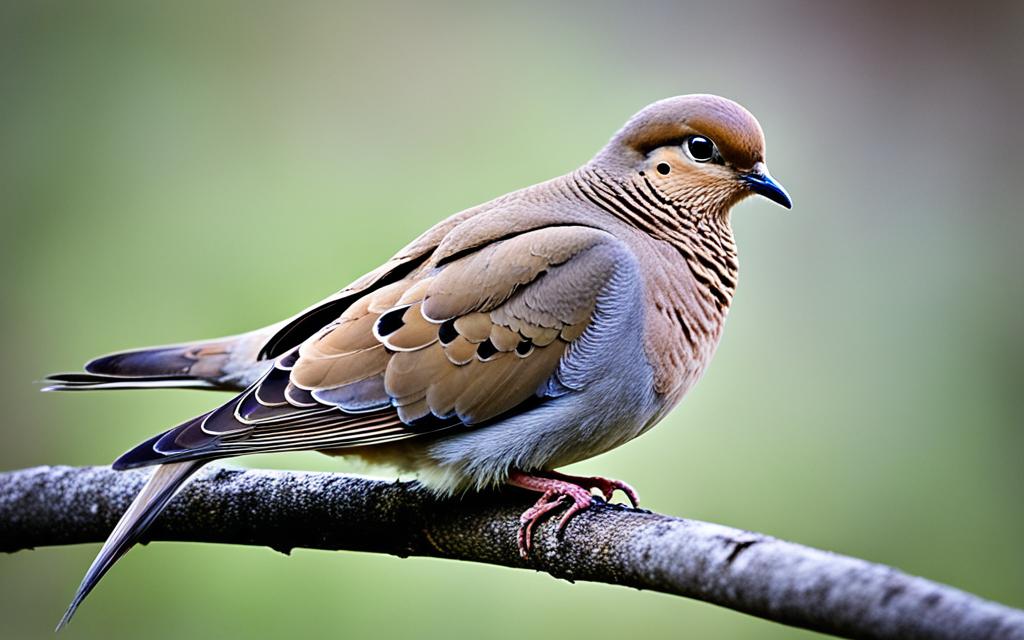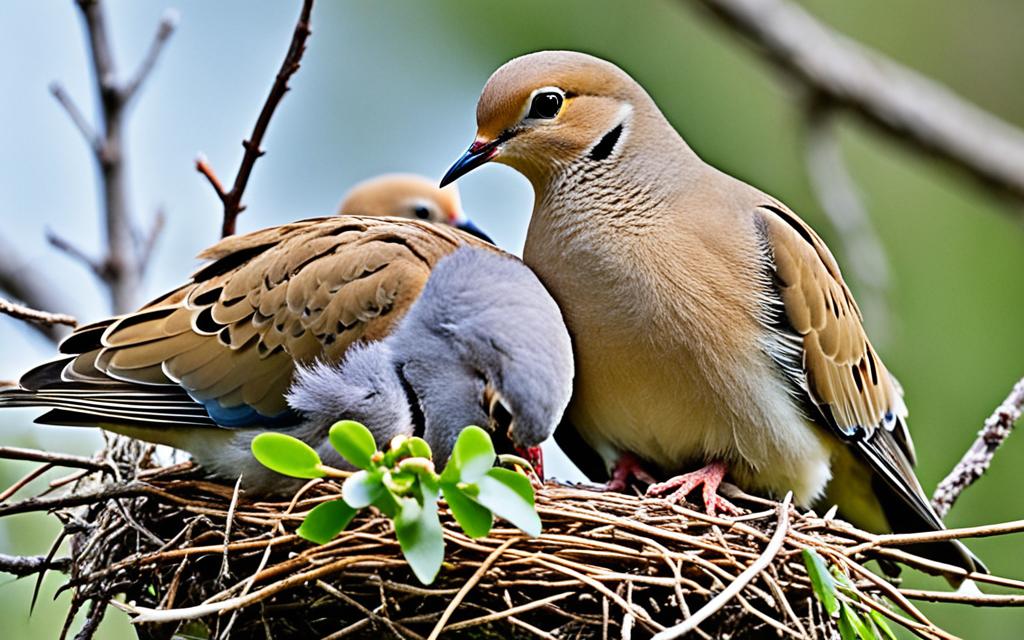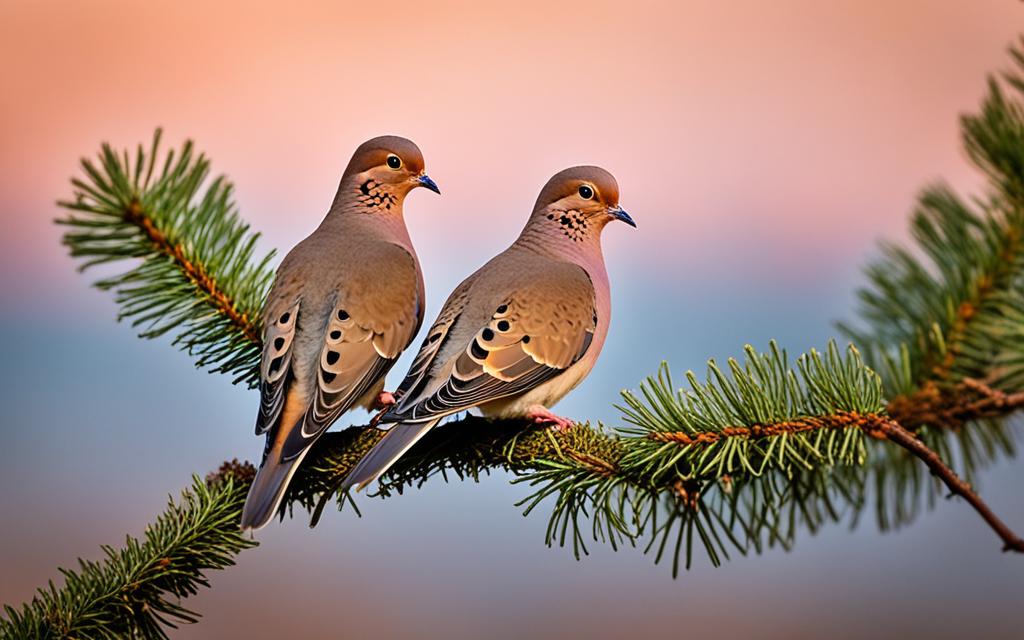As Ralph Waldo Emerson once said, “The earth laughs in flowers.” Indeed, the natural world is a tapestry of wonder and beauty, woven with the delicate threads of countless species, each playing a vital role in the intricate dance of life. Among these feathered marvels, the Mourning Dove (Zenaida Macroura) stands out as a true embodiment of grace and serenity.
This comprehensive article will delve into the fascinating world of Mourning Doves, a beloved and ubiquitous species of dove found across North America. Readers will discover the gentle demeanor, widespread distribution, distinctive physical characteristics, captivating behavioral patterns, and ecological importance of these gentle feathered friends. Through an in-depth exploration, this article aims to foster a deeper appreciation and understanding of these avian wonders.
Key Takeaways
- Mourning Doves are a beloved and ubiquitous species of dove found across North America.
- These gentle creatures are known for their peaceful presence and captivating cooing sounds.
- Mourning Doves exhibit a unique blend of physical characteristics, including a slender body, small head, and long tapered tail.
- These birds play a vital role in their ecosystems, serving as both granivores and a food source for other predators.
- By exploring the world of Mourning Doves, readers can deepen their appreciation for these gentle feathered friends and their valuable role in the natural world.
Introduction to Mourning Doves
The Mourning Dove (Zenaida Macroura) is a beloved and ubiquitous species of dove found across North America. These gentle creatures are known for their peaceful presence and calming cooing sounds that are often heard in backyards, parks, and other urban and rural environments. With a widespread distribution spanning from Canada to Mexico, Mourning Doves have adapted to a variety of habitats, making them a common sight in many regions.
Gentle Demeanor and Peaceful Presence
Mourning Doves are renowned for their gentle demeanor and peaceful presence. Their serene behavior and soothing vocalizations have endeared them to bird enthusiasts and nature observers alike, making them a cherished feathered friend in many backyard settings.
Widespread Distribution Across North America
With a range that extends from the boreal forests of Canada to the deserts of Mexico, the Mourning Dove (Zenaida Macroura) is truly a ubiquitous species of dove found throughout North America. This adaptability has allowed them to thrive in a diverse array of habitats, from urban to rural environments, contributing to their status as a common and beloved avian presence across the continent.
Mourning Doves: Distinctive Characteristics
Mourning Doves are easily recognizable by their distinctive physical features and captivating vocalizations. With their slender bodies, small heads, and long tapered tails, these Mourning Doves (Zenaida Macroura) possess a graceful and elegant appearance. Their plumage is a unique blend of soft gray, brown, and iridescent hues, which help them blend seamlessly into their natural surroundings.
Physical Appearance and Plumage
The Dove Species known as Mourning Doves are characterized by their sleek and streamlined appearance. Their delicate features, including their small heads and long, tapered tails, give them an air of refinement and charm. The soft tones of their Avian Behavior-adapted plumage, which ranges from soft gray to warm brown with iridescent accents, allow them to camouflage effortlessly in their environments.
Unique Cooing Calls and Vocalizations
One of the most distinctive characteristics of Mourning Doves is their haunting, mournful-sounding Cooing Sounds and Bird Calls. These captivating vocalizations have become a familiar and beloved part of their identity, often heard echoing through backyards, parks, and natural areas across North America.

Nesting Habits and Breeding Behavior
Mourning Doves (Zenaida Macroura) exhibit a fascinating array of nesting and breeding behaviors that are integral to their life cycle. These gentle Dove Species engage in captivating courtship rituals, showcasing their Avian Behavior through elaborate aerial displays and gentle cooing exchanges to establish strong pair bonds.
Courtship Rituals and Pair Bonding
As part of their Breeding Behavior, Mourning Doves can be observed performing intricate courtship dances, where the males take flight and dive, often accompanied by their distinctive, mournful-sounding calls. This mesmerizing display is a crucial step in the Doves’ Nesting Habits, as they work to attract a suitable mate and solidify their pair bond.
Nest Construction and Incubation Process
Once a pair of Mourning Doves have formed a strong bond, they collaborate to construct their nest, often utilizing twigs, grass, and other natural materials found in their environment. The female Dove then takes on the responsibility of incubating the eggs, while both parents share the duties of caring for the young dovelings as they grow and develop.
Caring for the Young Dovelings
As the Mourning Dove eggs hatch, the parents work tirelessly to provide for their offspring. Both the male and female Doves take turns feeding and protecting the young dovelings, ensuring their survival until they are ready to fledge and venture out on their own, continuing the cycle of Nesting Habits and Breeding Behavior for this beloved Dove Species.

Foraging and Dietary Preferences
Mourning Doves (Zenaida Macroura) are primarily granivorous, meaning they feed primarily on a diverse array of seeds and grains. These avian foragers play an important role in their ecosystems, consuming seeds from various plants and serving as a food source for other predators.
Mourning Doves: Avian Granivores
As Mourning Doves forage, they utilize their slender bills to carefully select and consume a wide range of seeds, including those from agricultural crops, wild grasses, and a variety of other plant species. This dietary preference allows them to thrive in both natural and human-influenced environments, making them a common sight in both rural and urban areas.
Importance in Ecosystems and Agriculture
The Mourning Dove’s role as a seed-eating avian species has significant implications for the ecosystems and agricultural practices they inhabit. On the one hand, their consumption of seeds helps to control the growth of certain plant species, maintaining the delicate balance of natural environments. However, their foraging on agricultural crops can also have negative impacts, potentially competing with human interests. This complex relationship highlights the Mourning Dove’s importance in the intricate web of ecosystems and the need for balanced management strategies that consider their ecological and agricultural significance.
Conclusion
The Mourning Dove, a beloved and ubiquitous species across North America, has captivated the hearts and minds of bird enthusiasts and nature observers alike. These gentle feathered friends, with their distinctive physical characteristics, captivating behavioral patterns, and ecological importance, have become an integral part of the natural landscapes that grace our backyards, parks, and rural environments.
By exploring the fascinating world of the Mourning Doves (Zenaida Macroura), readers have gained a deeper appreciation for these gentle creatures and their valuable role in the delicate balance of our shared ecosystems. From their avian behavior and cooing calls to their significance as backyard birds and wildlife observation, the Mourning Dove’s story is one of wonder, grace, and a enduring connection between humans and the feathered friends that grace our natural world.
As we continue to observe and appreciate the Mourning Doves that flutter through our lives, we are reminded of the importance of preserving and protecting the diverse dove species that contribute to the rich tapestry of our avian heritage. Through our continued fascination and stewardship, these gentle creatures will continue to captivate and inspire us for generations to come.




